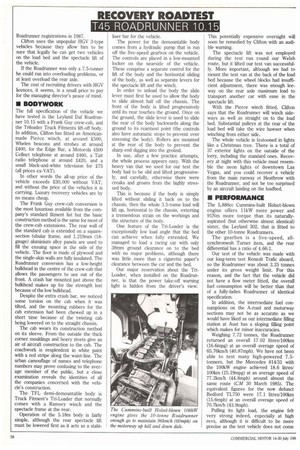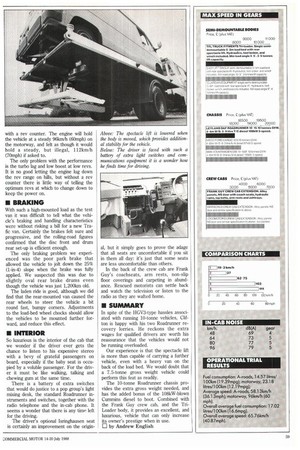RECOVERY ROADTEST 145 ROADRUNNER 10.15
Page 42

Page 43

If you've noticed an error in this article please click here to report it so we can fix it.
Roadrunner registrations in 1987.
Clifton uses the unpopular HGV 3-type vehicles because they allow him to be sure that legally he can get two vehicles on the load bed and the spectacle lift of the vehicle.
If the Roadrunner was only a 7,5-tonner he could run into overloading problems, or at least overload the rear axle.
The cost of recruiting drivers with HGV licences, it seems, is a small price to pay for the managing director's peace of mind.
• BODYWORK
The full specification of the vehicle we have tested is the Leyland Daf Roadrunner 10.15 with a Frank Guy crew-cab, and the Triloader Truck Fitments lift-off body. In addition, Clifton has fitted an Americanmade Pierce winch, at around 2500, Whelen beacons and strobes at around 2400, for the Edge Bar, a Motorola 4500 Cellnet telephone at around 2460, a Tait radio telephone at around 2420, and a small black-and-white television for 275 (all prices ex-VAT).
In other words the all-up price of the vehicle exceeds 230,000 without VAT, and without the price of the vehicles it is carrying. Luxury recovery vehicles are by no means cheap.
The Frank Guy crew-cab conversion is the most luxurious available from the company's standard fitment list but the basic construction method is the same for most of the crew-cab extensions. The rear wall of the standard cab is extended on a squaresection tubular frame, and 1.219rrun (18gauge) aluminium alloy panels are used to fill the ensuing space in the side of the vehicle. The floor is made of plywood and the single-skin walls are fully insulated. The Roadrunner conversion has a low-height bulkhead in the centre of the crew-cab that allows the passengers to see out of the front. A crash bar mounted just above the bulkhead makes up for the strength lost because of the low bulkhead.
Despite the extra crash bar, we noticed some torsion on the cab when it was tilted, and the mounting rubbers for the cab extension had been chewed up in a short time because of the twisting cab being lowered on to the straight chassis.
The cab wears its construction method on its sleeve. From the outside the thick corner mouldings and heavy rivets give an air of aircraft construction to the cab. The coachwork is resplendent in white paint with a red stripe along the waist-line. The urban camouflage of names and telephone numbers may prove confusing to the average member of the public, but a close examination reveals the identities of all the companies concerned with the vehicle's construction.
The TFL demi-demountable body is Truck Fitment's Tr-Loader that normally comes with a Ramsey winch and the spectacle frame at the rear.
Operation of the 5.18m body is fairly simple, although the rear spectacle lift must be lowered first as it acts as a stabi liser bar for the vehicle.
The power for the demountable body comes from a hydraulic pump that is run off the five-speed gearbox on the vehicle. The controls are placed in a low-mounted locker on the nearside of the vehicle. These comprise a separate control for the lift of the body and the horizontal sliding of the body, as well as separate levers for the spectacle lift and the winch.
In order to unload the body the slide lever must first be used to allow the body to slide almost half off the chassis. The front of the body is lifted progressively until its rear touches the ground. Once on the ground, the slide lever is used to slide the rear of the body backwards along the ground to its rearmost point (the controls also have automatic stops to prevent over stressing the body). Rollers are mounted at the rear of the body to prevent the sharp end digging into the groimd.
In use, after a few practice attempts, the whole process appears easy. With the heavy van that we used for our test the body had to be slid and lifted progressively, and carefully, otherwise there were creaks and groans from the highly stressed body.
This is because if the body is simply lifted without sliding it back on to the chassis, then the whole 3.5-tonne load will lift up, horizontal to the chassis, exterting a tremendous strain on the workings and the structure of the body.
One feature of the Tri-Loader is the exceptionally low load angle that the bed can achieve when fully extended. We managed to load a racing car with only 38mm ground clearance on to the bed with no major problems, although there was little, more than a cigarette paper's clearance between the car and the bed.
Our major reservation about the TrLoader, when installed on the Roadrunner, is that the power take-off warning light is hidden from the driver's view. This potentially expensive oversight will soon be remedied by Clifton with an audible warning.
The spectacle lift was not employed during the test run round our Welsh route, but it lifted our test van successfully. More important, although we had to mount the test van at the back of the load bed because the wheel blocks had insufficient adjustment, there was enough leeway on the rear axle maximum load to transport another car with ease in the spectacle lift.
With the Pierce winch fitted, Clifton says that the Roadrunner will winch sideways as well as straight on to the load bed. Substantial pulleys at the rear of the load bed will take the wire hawser when winching from either side.
The whole vehicle is festooned in lights like a Christmas tree. There is a total of 37 exterior lights on the outside of the lorry, including the standard ones. Recovery at night with this vehicle must resemble the neon lights of downtown Las Vegas, and you could recover a vehicle from the main runway at Heathrow with the Roadrunner, and not be too surprised by an aircraft landing on the loadbed.
III PERFORMANCE
The 5,880cc Cummins-built Holset-blown engine offers 11kW more power and 91Nm more torque than its naturallyaspirated (but otherwise almost identical) sister, the Leyland 302, that is fitted to the other 10-tonne Roadrunners.
The gearbox is a five-speed, allsynchromesh Turner item, and the rear differential has a ratio of 4.66:1.
Our test of the vehicle was made with our long-term test Renault Trafic aboard, so the Roadrunner was about 2.25 tonnes under its gross weight limit. For this reason, and the fact that the vehicle did not have a flow meter fitted, the overall fuel consumption will be better than that of a fully-laden Roadrunner of identical specification.
In addition, the intermediate fuel consumptions on the A-road and motorway sections may not be as accurate as we would have liked as our intermediate filling station at Aust has a sloping filling point which makes for minor inaccuracies.
Weighing 7.72 tonnes, the Roadrunner returned an overall 17.02 litres/100km (16.6mpg) at an overall average speed of 65.76Icm/h (40.87mph). We have not been able to test many high-powered 7.5tonners, but the Mercedes 814/31 with the 100kW engine achieved 18.6 litres/ 100km (15.19mpg) at an average speed of 77.21cm/h (44.8mph) around almost the same route (CM 30 March 1985). The equivalent figures for the now defunct Bedford TL750 were 17.1 litres/1001cm (15.6mph) at an overall average speed of 70.7km/h (43.9mph).
Pulling its light load, the engine felt very strong indeed, especially at high revs, although it is difficult to be more precise as the test vehicle does not come
with a rev counter. The engine will hold the vehicle at a steady 961crnih (60mph) on the motorway, and felt as though it would hold a steady, but illegal, 112km/h (70mph) if asked to.
The only problem with the performance is the turbo lag and low boost at low revs. It is no good letting the engine lug down the rev range on hills, but without a rev counter there is little way of telling the optimum revs at which to change down to keep the power on.
• BRAKING
With such a high-mounted load as the test van it was difficult to tell what the vehicle's braking and handling characteristics were without risking a bill for a new Trafic van. Certainly the brakes felt sure and progressive, and the rolling-road figures confirmed that the disc front and drum rear set-up is efficient enough.
The only braking problem we experienced was the poor park brake that allowed the vehicle to jolt down the 25% (1-in-4) slope when the brake was fully applied. We suspected this was due to slightly oval rear brake drums even though the vehicle was just 1,200kin old.
The laden ride is good, although we did find that the rear-mounted van caused the rear wheels to steer the vehicle a bit round fast, bumpy corners. Adjustments to the load-bed wheel chocks should allow the vehicles to be mounted further forward, and reduce this effect
• INTERIOR
So luxurious is the interior of the cab that we wonder if the driver ever gets the chance to listen to his expensive stereo with a bevy of grateful passengers on board, especially if the baby seat is occupied by a voluble passenger. For the driver it must be like walking, talking and chewing gum at the same time.
There is a battery of extra switches that would do justice to a pop group's light mixing desk, the standard Roadrunner instruments and switches, together with the radio telephone and the in-cab. phone. It seems a wonder that there is any time left for the driving.
The driver's optional Isringhausen seat is certainly an improvement on the origin al, but it simply goes to prove the adage that all seats are uncomfortable if you sit in them all day: it's just that some seats are less uncomfortable than others.
In the back of the crew cab are Frank Guy's coachseats, arm rests, non-slip floor coverings and carpeting in abundance. Rescued motorists can settle back and watch the television or listen to the radio as they are wafted home.
• SUMMARY
In spite of the HGV3-type hassles associated with running 10-tonne vehicles, Clifton is happy with his two Roadrunner recovery lorries. He reckons the extra wages for qualified drivers are worth his reassurance that the vehicles would not be running overloaded.
Our experience is that the spectacle lift is more than capable of carrying a further vehicle, even with a heavy van on the back of the load bed. We would doubt that a 7.5-tonne gross weight vehicle could perform this feat as readily.
The 10-tonne Roadrunner chassis provides the extra gross weight needed, and has the added bonus of the 108kW-blown Cummins diesel to boot. Combined with the Frank Guy crew cab, and the TrLoader body, it provides an excellent, and luxurious, vehicle that can only increase its owner's prestige when in use. 111 by Andrew English














































